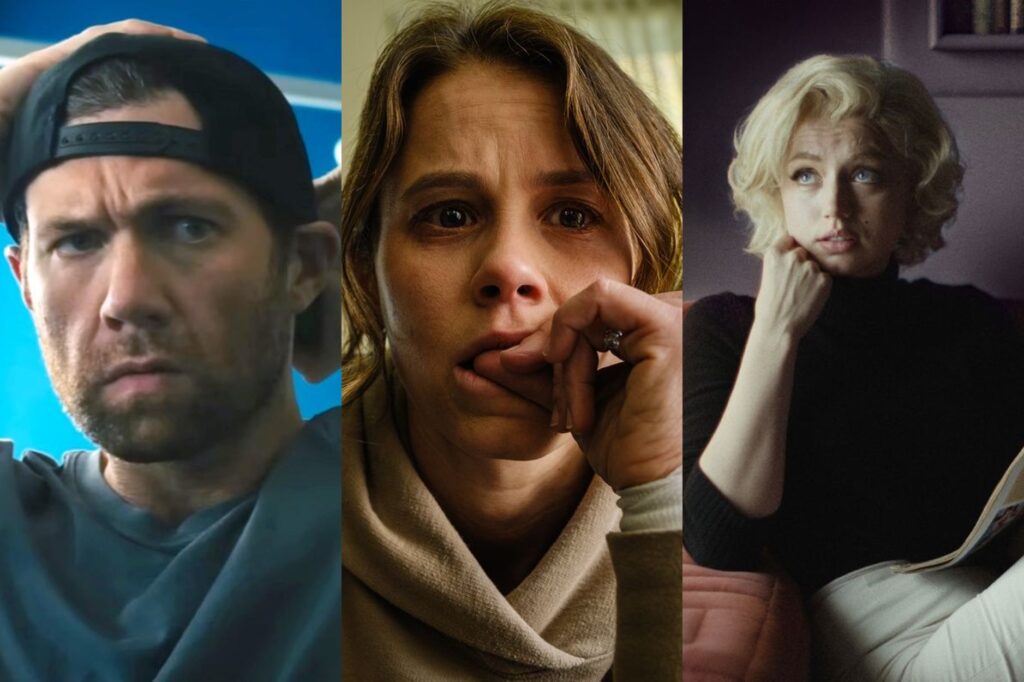
Not every movie needs to be revolutionary. Genres are durable in part because filmmakers have gradually honed reliable formulae, the passage of time sanding down eons of cinematic experimentation into sturdy templates. Predictability can be dispiriting, but the successful execution of a familiar blueprint can also be satisfying. This past weekend saw three different movies tackle three very different genres, and though none can be mistaken for each other, they all operate with a certain degree of conventionality. Not coincidentally, they’re all watchable while also struggling to break free from the shackles of expectations.
Few movies are more visibly conscious of their place within an established genre than Bros. How conscious? It’s a romantic comedy co-written by Billy Eichner that opens with a character played by Billy Eichner recounting a pitch session in which a studio mogul urges him to write a romantic comedy. The hook, the suit explains, will be that the film will center on gay men but will otherwise follow the standard rom-com playbook, thereby perpetuating the message that “love is love.” Eichner’s character, Bobby, isn’t having it. “Love is not love,” he insists. Gay people are different; you can’t just magically flip the characters’ sexual orientation and expect everything else to cleanly lock into place.
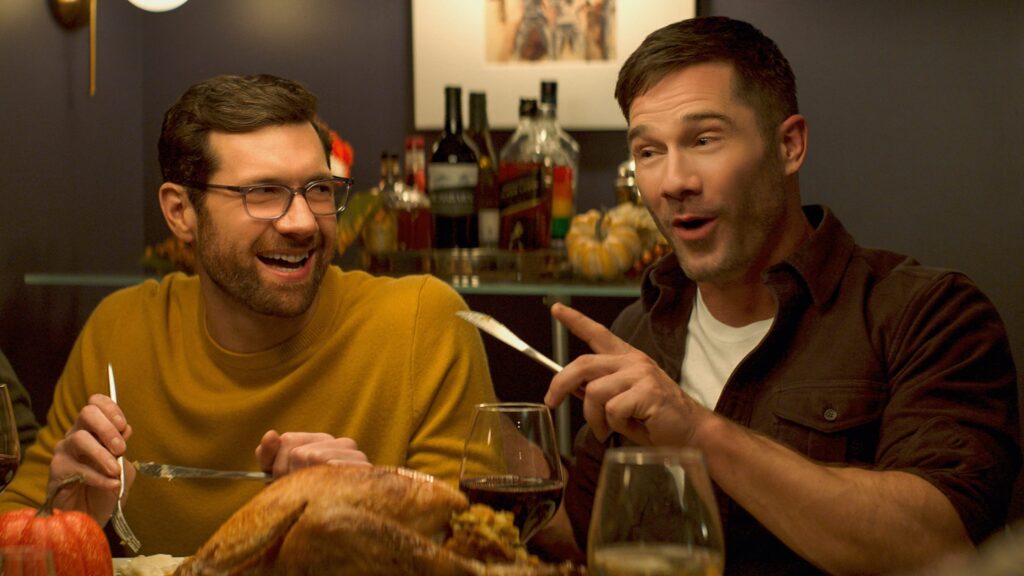
It’s a valid point, but it places Bros in a curious position. The movie takes pains to emphasize various elements of gay culture, and to articulate the idea that queerness—which of course comprises a wide spectrum of identity and behavior—is central to its characters’ lives, in ways that extend beyond physical appearance and chemical attraction. Bobby, in addition to hosting a salty and cranky podcast, is the curator of an upcoming LGBTQ+ museum in New York, and one of the challenges of his work is navigating the particular desires and caprices of the fellow members of his board—all of whom defy cishet norms, none of whom ever seem to agree on anything. In his personal life, he eschews long-term relationships in favor of casual sex, and he routinely laments the irritations of the Grindr lifestyle, from the awkward smartphone courtships (“lol ass pic?”) to the faux-macho posturing to the fact that most of the men he sleeps with tend to be quite dumb.
So no, Bros is decidedly not a typical romantic comedy in which the characters just happen to be gay. At the same time, the movie hits the expected beats with alarming regularity, as though the genre’s trajectory is so hard-wired that no amount of talk about bottoms or Debra Messing or Lincoln’s supposed bisexuality can knock it off its predetermined course. Despite his emotional fortifications, Bobby falls for Aaron (Luke Macfarlane), a muscle-bound lawyer who’s similarly uninterested in commitment, and their ensuing relationship, with its apexes and pitfalls, is both charming and mechanical, embroidered with the usual accoutrements of cuteness. The montages of compatible lovers cheerfully walking and talking on sunlit streets? The quirky friends and relatives on hand to provide comic relief and moral support? The manufactured complications and corresponding earnest speeches? The exhortations to quit your soul-crushing job so you can finally pursue your malnourished dreams? It’s all here. Love may not be love, but rom-coms are still rom-coms.
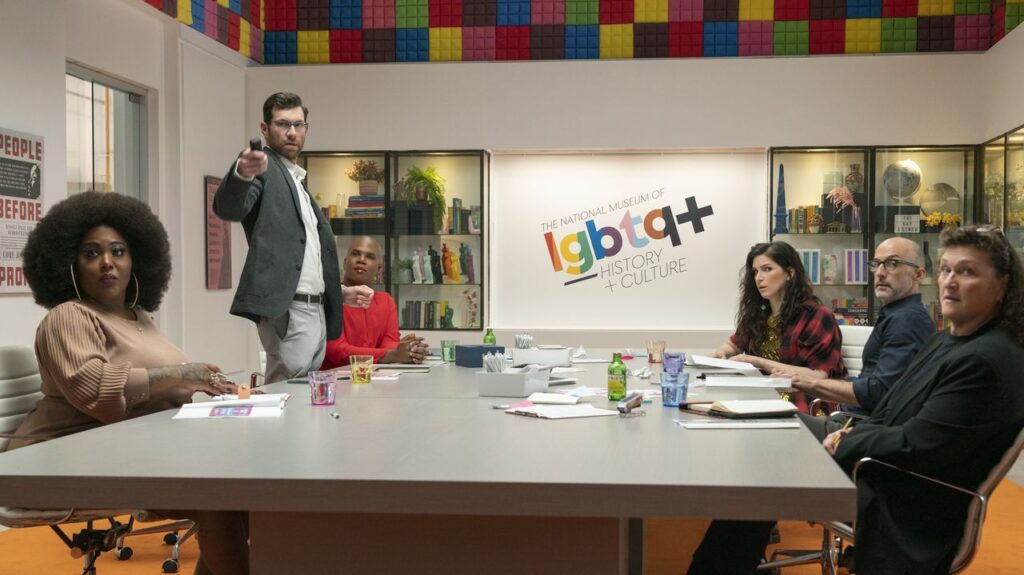
None of this familiarity prevents Bros from being enjoyable; to the contrary, pleasantness is coded into the genre’s DNA. As a leading man, Eichner is appealingly standoffish, spiking the standard “hard-hearted softy” routine with dollops of vinegar; the sequence in which Bobby gently but persistently spars with Aaron’s mother about teaching the existence of gay people to her second-grade students verges on legitimately tense. And while Bobby professes to support straight men portraying gay celebrities (“I want Benedict Cumberbatch to win an Oscar for playing me”), Eichner and his co-writer, Nicholas Stoller (who also directed), have rounded out the cast with charismatic queer actors (including Jim Rash, Ts Madison, and Eve Lindley) who collectively bring verisimilitude to the film’s gleefully non-conforming universe.
Yet while Bros is consistently engaging and occasionally transgressive (if nothing else, it’s refreshingly frank about sex), it’s lacking in true punch or zip. The scenes of museum staffers squabbling, which should serve as consistent comic highlights, tend to wander, while some of the bawdier bits, such as a polyamorous sex scene featuring an uninvited guest, fall flat. And while the script recognizes that a significant chunk of modern courtship takes place via text, Stoller struggles to infuse digital communications with verbal or visual verve. On the whole, Bros is more amusing than uproarious, and though that’s hardly unprecedented, it inadvertently magnifies the movie’s clandestine ordinariness. For a proudly gay rom-com, it plays things disappointingly straight.
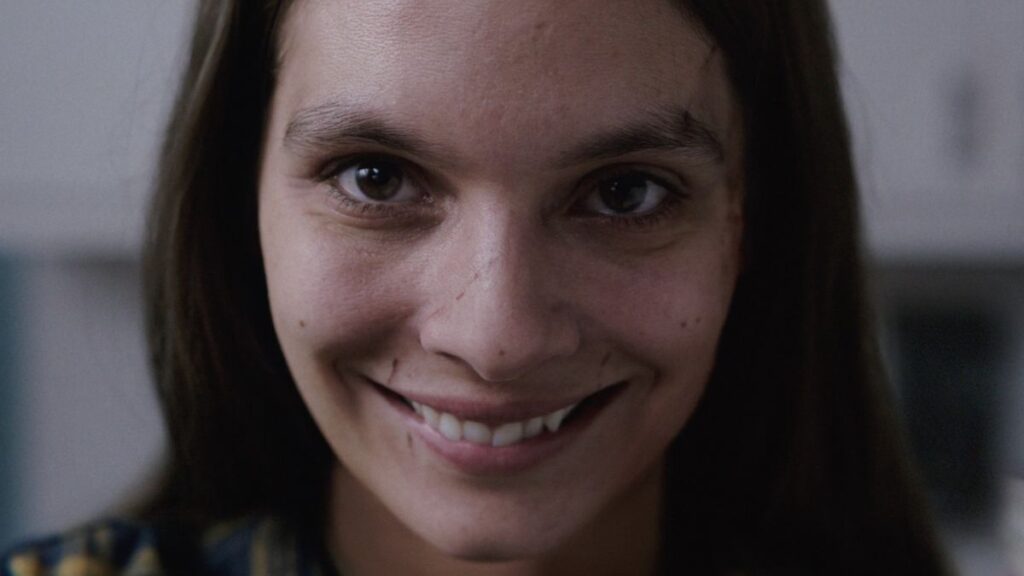
If Bros purports to nudge its genre into uncharted territory, Smile possesses no such pretensions. It’s a pure, unadulterated horror movie, albeit one accompanied by the requisite contemporary themes of trauma and grief. The debut feature from writer-director Parker Finn, it doesn’t try to push the boundaries of its archetype but to burrow deep inside its existing tropes, generating suspense through the brute power of its execution. It doesn’t always work; despite its repeated (and repetitive) shocks, the film is too safe and conventional to truly leave a mark. But it’s still made with skill, and in certain moments it transcends its familiarity with exhilarating flair.
The first of those moments arrives immediately, suggesting that you might be settling in for a modern classic. We begin in a darkened bedroom with that most ominous of tone-setters, a dead body, before the camera slowly glides toward the doorway, exposing evidence of a bender (an empty wine bottle, multiple pill vials) before it locates a helpless and stricken young girl. Flash forward a few decades, and that girl has aged into our heroine, a doctor named Rose (Sosie Bacon), who jerks awake from the painful memory before making her rounds at a psychiatric hospital. She hears word of a troubled young woman and is soon counseling Laura (Caitlin Stasey), a grad student who insists that she’s being tormented by malevolent visions. “This is a safe place,” Rose assures Laura, her soothing voice complemented by a cozy pair of plush blue chairs and a vase filled with bright yellow flowers. Yet soon Laura is screaming in terror, and Rose is racing to the phone to call security, and suddenly the agonized shrieks are replaced by eerie silence, and Rose turns around and…
It seems absurd for me to worry about spoiling a movie’s cold open, but the culmination of this masterful sequence—featuring a rictus grin, a fragmented piece of pottery, and a torrent of blood—is so spell-binding, I want you to see it for yourself. (Naturally, it’s in the trailer.) It instantly establishes Finn’s technical bona fides—his talent for patient camera moves and creepy scene-setting—while also demonstrating that in pure gorehound terms, he is not fucking around.

The majority of what follows is similarly competent but far less riveting. Much as Laura claimed, Rose finds herself gradually but persistently beset by disturbing visions—a creepy assortment of nightmares, specters, and hallucinations. These all arrive according to the same pattern: Rose sees or hears something perplexing, she furrows her brow and leans forward to investigate, the sound mix hushes to a whisper, and then BOOM! something ungodly bursts onto the screen, only to be revealed as not really being there at all. This trusty method of jangling our nerves is consistently scary but also kind of cheap, and the repetition creates a diminishing effect, dulling our capacity to be surprised.
To be fair, Finn doesn’t rely exclusively on fakeouts and jump scares; at times, the threats to Rose are more sustained and thus more unsettling. These most often occur when she sees random people smiling at her—not in a friendly way, but sporting frozen, demented leers. (Strangely enough, one of the more chilling scenes involves a foe Rose can’t see at all, when a 911 operator asks if she’s alone in her house and then poses a follow-up question, her voice acquiring the slightest twinge of menace: “Are you sure?”) A sequence at a birthday party, in which a child eagerly unwraps a ghastly birthday gift, is deliciously paced, delaying the inevitable jolt for as long as possible.
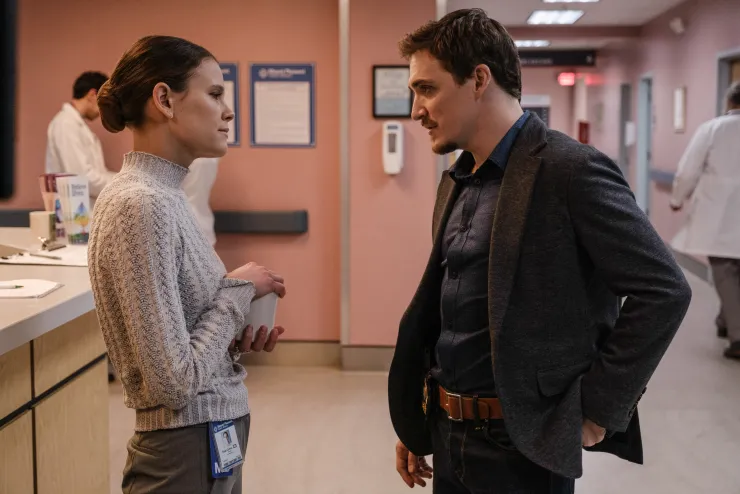
“He’s traumatized!” someone snaps at Rose. He isn’t the only one. The supernatural plot of Smile involves a curse which—as in the case of antecedents like It Follows, The Ring, and Fallen—invisibly passes its way from one victim to the next, leaving an inexplicable trail of death and bloodshed in its wake. Thematically, the movie attempts to position itself as a metaphorical study of the cyclical, recursive nature of abuse, and how old scars never really heal; if you had any doubt of this, there’s a scene where a character literally says of the unseen monster, “It feeds on trauma!” There’s something admirable about Finn’s textual bluntness, but his literalization of madness still doesn’t carry much weight (it’s certainly nowhere near as provocative as the inexorable pursuit of evil in It Follows), nor does it excuse the blatant conventionality of his screenplay, which supplies the obligatory scenes of Google searches, relationship breakdowns, and expository asylum visits.
In light of its electrifying introduction, Smile’s rigorous adherence to this hoary fright template is a little disappointing, but Finn’s execution is sharp enough to keep you engaged. He also dabbles in some cheeky humor, as when Rose absent-mindedly sips coffee from a mug with a smiley face emblazoned on it, or when she warily eyes one of those pain assessment charts dotted with cheerful emojis. Smile may traffic in horror and brutality, but it’s most effective when it puts on a happy face.
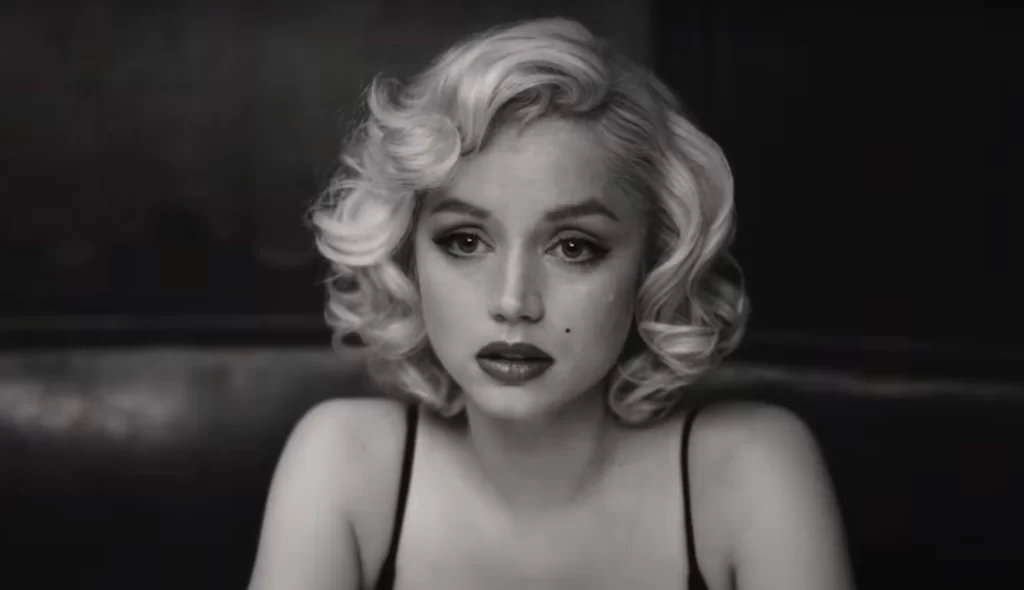
There is little happiness to be found in Blonde, though it bears more similarities to Smile than you might expect, and not just because at one point a woman holds a razor blade to her throat. Based on a novel by Joyce Carol Oates, it examines the (fictionalized) life of Marilyn Monroe (played as a child by Lily Fisher, then as an adult by Ana de Armas), and it’s steeped in so much trauma as to make the characters in a horror movie look sanguine by comparison. The work of Andrew Dominik, it’s a film that takes natural beauty and filters it through the inherent ugliness of celebrity.
Or at least that’s the idea. Despite skipping across the recognizable touchstones of Monroe’s life, Blonde isn’t really a biopic. It’s more of an anti-biopic, the burgeoning subgenre in which filmmakers begin with the approximation of a famous figure, then strip it down and mine it for thematic insight and psychological complexity. (Recent examples include Shirley, Josephine Decker’s bleak study of Shirley Jackson, and Spencer, Pablo Larraín’s glum look at Princess Diana.) With Blonde, Dominik isn’t trying to paint a hagiographic portrait of an American icon. Instead he wants to dig under the skin, and to reveal the numbing pain and existential confusion that are the apparent price of female fame.
Yet despite these lofty aims, Blonde is oddly traditional in scope and structure. After a brief opening that establishes the childhood despair of one Norma Jeane Mortenson (dad is gone, mom is losing it), the film functions as a straightforward tour of Monroe’s movies and her men. We see her audition for Don’t Bother to Knock, smile as she warbles about diamonds in Gentlemen Prefer Blondes, gape as her dress billows above a subway grate in The Seven Year Itch, and wince as she howls at Billy Wilder on the set of Some Like It Hot. Along the way, Norma Jeane/Marilyn becomes possessed by a hulking Joe DiMaggio (played by an unfortunate Bobby Cannavale), enchants a helpless Arthur Miller (Adrien Brody, reasonably restrained), and scuttles into a hotel room with a distracted John F. Kennedy (Caspar Phillipson).
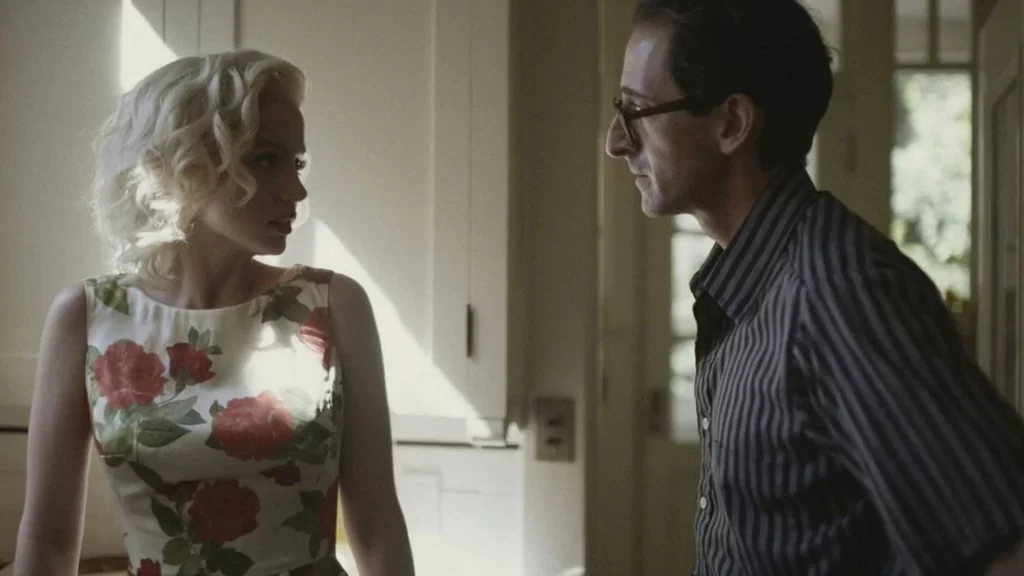
The last of those brutes subjects her to a humiliating act which exemplifies the movie’s spirit of putative provocation; Blonde, as you’ve likely heard by now, has been rated NC-17 for what might be described as “sexual content, along with a suffocating atmosphere of relentless misery.” Not that the two are necessarily synonymous. If anything, some of the film’s debauched early scenes—which find Norma Jeane hurling herself into a throuple with the caddish sons of Charlie Chaplin and Edward G. Robinson, and engaging in gymnastic activities with an enthusiasm that might make the dudes from Bros blush—are strangely sweet, if only because our grief-stricken heroine actually seems to be enjoying herself.
For the most part, though, this is a punishing picture, and its brazen departures from the historical record do little to discourage the impression that it’s just another joyless depiction of a sad artist with drug problems and daddy issues. There’s even a bizarre subplot about abortion—Marilyn seems to converse with her fetus, which Dominik represents in bulbous CGI form and glowing amber light—which advocates have criticized as being anti-choice. I don’t really buy that line of attack—not because the movie is actually left-wing, but because it’s too vague to possess any sort of ideology whatsoever. The termination of Marilyn’s pregnancy (which seems to be voluntary, until maybe it isn’t) is just one of many stops along a bumpy road that is paved with disconsolation and regret.
There are really only two reasons to see Blonde, though they’re awfully good reasons. One is the sheer force of Dominik’s craft. This is a gorgeous movie, replete with richly textured images and bravura stylistic flourishes. Dominik and his cinematographer, Chayse Irvin, shoot primarily in lush black-and-white but regularly add splashes of color, and while there isn’t much significance to the scheme, the arresting results are undeniable; the same is true of their frequent tweaks to the aspect ratio, occasionally widening out the claustrophobic frame to enhance the sense of theatricality. (The film sounds great too, thanks to the swoony, electronica-tinged score by Nick Cave and Warren Ellis, who also worked on Dominik’s epic western, The Assassination of Jesse James by the Coward Robert Ford.) The early sequence in which Norma Jeane’s mother (a persuasively unhinged Julianne Nicholson) drives them up a mountainside toward a blazing fire, orange sparks floating in the ether as their car pushes into the mist, harnesses a terrible beauty—a haunting bleed of heaven and hell.
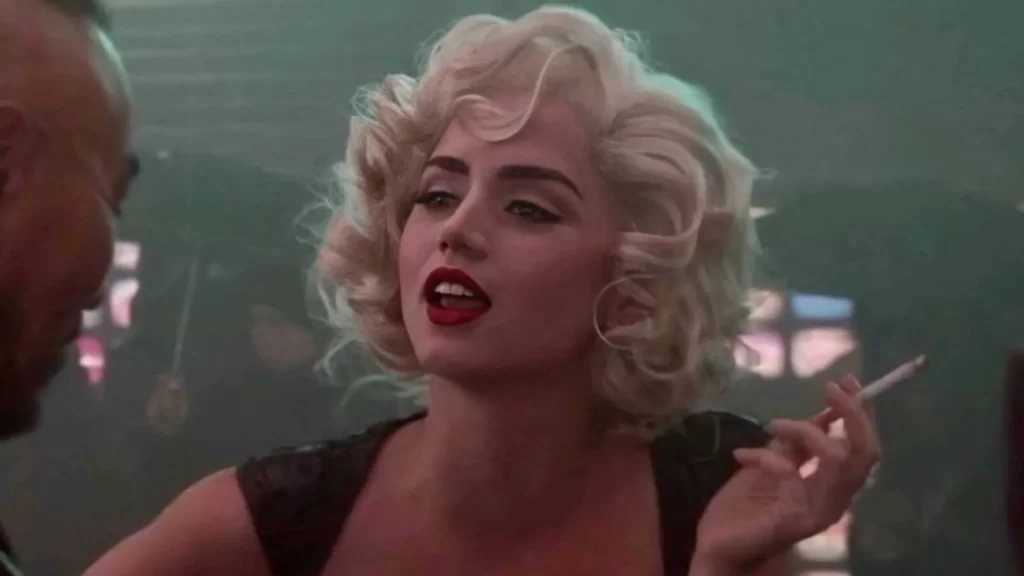
Throughout, Dominik’s camera locates no sight more captivating than his leading lady’s face, which brings me to the other reason to see Blonde: de Armas’ fearless performance. Refusing to turn Marilyn into either a victim or a harpy, she instead locates a measure of dignity beneath all of the sobbing and the shrieking, turning the legend into a frail and broken soul who was also a formidable presence. She doesn’t so much elevate the material as patch it up, preventing it from sinking into a deadening collage of anguish. That early screen test for Don’t Bother to Knock is a single-take marvel, creating a nested blurring of actor and character—de Armas is playing Norma Jeane, who’s playing Marilyn, who’s playing Nell—and even as the story wallows in cliché, de Armas never loses sight of her counterpart’s brittle longing.
Dominik may match his star’s commitment, but he lacks her discipline. Blonde runs 167 minutes, and while it’s never boring, it’s rarely entertaining, instead getting pulled into the undertow of its own death march. Marilyn Monroe’s life may have ended in tragedy, but in obsessing over her loneliness, Dominik has blotted out her vivacity, not so much exploiting her legacy as flattening it into just another celebrity dirge. He’s a gifted filmmaker, but he’s too enamored with Hollywood’s penchant for eating its own. When it comes to biopics, it would appear there’s no business like low business.
Grades
Bros: B-
Smile: B-
Blonde: C+
Jeremy Beck is the editor-in-chief of MovieManifesto. He watches more movies and television than he probably should.
